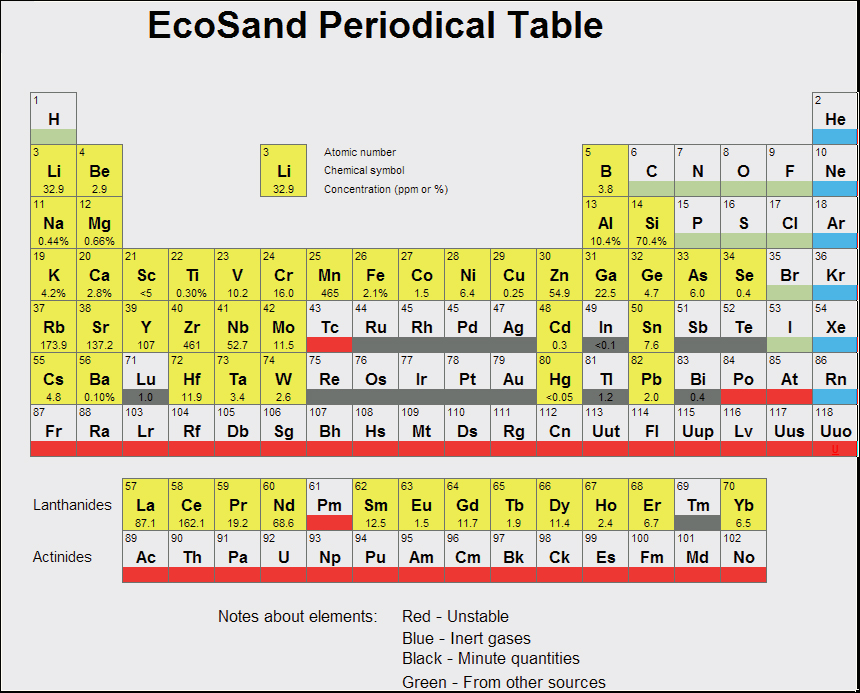
The Corales Golf Club designed by Tom Fazio at the Puntacana Resort & Club
Provides Trace Elements
EcoSand contains over 75 elements including macro, micro, and trace elements. Many elements in EcoSand are in large enough quantities to be beneficial in plant and turf growth. In addition to having a full suite of elements, EcoSand has a high cation exchange capacity.
For centuries, fertilizer, soil additives and natural mineral products have been used to help replace the nutrients lost from leaching and growing crops. With the identification of 16 essential macro and micro elements for plant growth, fertilizer and management practices changed to ensure that these elements are added as needed. Trace elements in the soil have been replaced by the addition of a wide variety of remineralizing products.
The scientific community after many well replicated tests generally agrees that many mineralization products give measurable benefits due to the availability of trace elements. While the exact trace elements that give these benefits have not been identified, many elements are unreactive, unstable, too low in concentration or available from other sources, and as such can be eliminated as potential candidates.
Trace Elements
EcoSand contains a long list of elements. An EcoSand analysis gave the following results:
|
|||||||||
|
ELEMENT
|
|||||||||
|
Aluminum (Al)
|
|||||||||
|
Antimony (Sb)
|
|||||||||
|
Argon (Ar)
|
|||||||||
|
Arsenic (As)
|
|||||||||
|
Barium (Ba)
|
|||||||||
|
Beryllium (Be)
|
|||||||||
|
Bismuth (Bi)
|
|||||||||
|
Boron (B)
|
|||||||||
|
Bromine (Br)
|
|||||||||
|
Cadmium (Cd)
|
|||||||||
|
Calcium (Ca)
|
|||||||||
|
Carbon (C)
|
|||||||||
|
Cerium (Ce)
|
|||||||||
|
Cesium (Cs)
|
|||||||||
|
Chlorine (Cl)
|
|||||||||
|
Chromium (Cr)
|
|||||||||
|
Cobalt (Co)
|
|||||||||
|
Copper (Cu)
|
|||||||||
|
Dysprosium (Dy)
|
|||||||||
|
Erbium (Er)
|
|||||||||
|
Europium (Eu)
|
|||||||||
|
Fluorine (F)
|
|||||||||
|
Gadolinium (Gd)
|
|||||||||
|
Gallium (Ga)
|
|||||||||
|
Germanium (Ge)
|
|||||||||
|
Gold (Au)
|
|||||||||
|
Hafnium (Hf)
|
|||||||||
|
Helium (He)
|
|||||||||
|
Holmium (Ho)
|
|||||||||
|
Hydrogen (H)
|
|||||||||
|
Indium (In)
|
|||||||||
|
Iodine (I)
|
|||||||||
|
Iridium (Ir)
|
|||||||||
|
Iron (Fe)
|
|||||||||
|
Krypton (Kr)
|
|||||||||
|
Lanthanum (La)
|
|||||||||
|
Lead (Pb)
|
|||||||||
|
Lithium (Li)
|
|||||||||
|
Lutetium (Lu)
|
|||||||||
|
Magnesium (Mg)
|
|||||||||
|
Manganese (Mn)
|
|||||||||
|
Mercury (Hg)
|
|||||||||
|
Molybdenum (Mo)
|
|||||||||
|
Neodymium (Nd)
|
|||||||||
|
Neon (Ne)
|
|||||||||
|
Nickel (Ni)
|
|||||||||
|
Niobium (Nb)
|
|||||||||
|
Nitrogen (N)
|
|||||||||
|
Osmium (Os)
|
|||||||||
|
Oxygen (O)
|
|||||||||
|
Palladium (Pd)
|
|||||||||
|
Phosphorus (P)
|
|||||||||
|
Platinum (Pt)
|
|||||||||
|
Potassium (K)
|
|||||||||
|
Praseodymium (Pr)
|
|||||||||
|
Rhenium (Re)
|
|||||||||
|
Rhodium (Rh)
|
|||||||||
|
Rubidium (Rb)
|
|||||||||
|
Ruthenium (Ru)
|
|||||||||
|
Samarium (Sm)
|
|||||||||
|
Scandium (Sc)
|
|||||||||
|
Selenium (Se)
|
|||||||||
|
Silicon (Si)
|
|||||||||
|
Silver (Ag)
|
|||||||||
|
Sodium (Na)
|
|||||||||
|
Strontium (Sr)
|
|||||||||
|
Sulfur (S)
|
|||||||||
|
Tantalum (Ta)
|
|||||||||
|
Tellurium (Te)
|
|||||||||
|
Terbium (Tb)
|
|||||||||
|
Thallium (Tl)
|
|||||||||
|
Thorium (Th)
|
|||||||||
|
Thulium (Tm)
|
|||||||||
|
Tin (Sn)
|
|||||||||
|
Titanium (Ti)
|
|||||||||
|
Tungsten (W)
|
|||||||||
|
Uranium (U)
|
|||||||||
|
Vanadium (V)
|
|||||||||
|
Xenon (Xe)
|
|||||||||
|
Ytterbium (Yb)
|
|||||||||
|
Yttrium (Y)
|
|||||||||
|
Zinc (Zn)
|
|||||||||
|
Zirconium (Zr)
|
|||||||||
|
© ZEO, Inc. EcoSand Green Soil Amendment
|
|||||||||
Some elements found in EcoSand and other products can be eliminated as potentially beneficial due to their being:
- Inert Gases
- Noble Metals
- Low Concentration
- Unstable (Radioactive)
- More Available from Other Sources
The inert gases and noble metals, like their names, indicate they lack the reactivity to be good candidates. Many elements including the unstable and radioactive elements are in too low a concentration to supplement native soils. Likewise, many elements are already in the soil at a much higher concentration than the remineralizing products add.
The 45 or so remaining elements that EcoSand could contribute explain why EcoSand functions as a remineralizing product. In the following periodical table, the yellow highlighted elements are in EcoSand, and their concentrations are given below the element’s symbol.
Compared to the other remineralizing products, EcoSand also supplies a high level of trace elements and has a much higher cation exchange than any other commercial product. For a comparison of EcoSand to greensand and Azomite (a clay) see EcoSand vs. Greensand and Azomite (printable PDF file).
